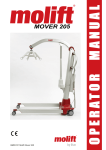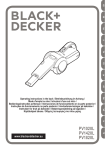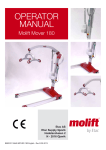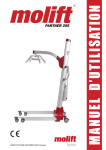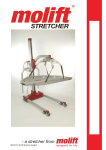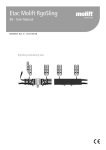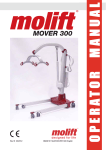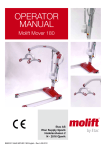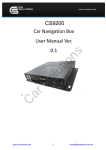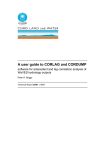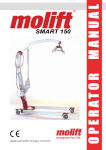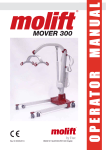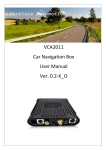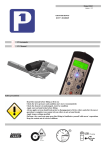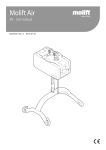Download Brukermanual MOLIFT Partner
Transcript
BM03101 Molift Partner 255 English Table of Contents General advice................................................... 3 Explanation of symbols................................ 3 Before using the patient lifter....................... 3 Responsibility............................................... 3 Safety precautions........................................... 4 General........................................................ 4 If defects or faults occur............................... 4 Lift and transfer............................................ 4 Maintenance..................................................... 20 Cleaning..................................................... 20 Monthly inspection..................................... 20 Periodic inspection..................................... 20 Service....................................................... 20 Troubleshooting.......................................... 21 Labelling..................................................... 21 Checklist for periodic inspection................ 23 About the product............................................ 5 Main parts.................................................... 5 Safety devices.............................................. 5 Technical data.................................................... 6 Assembly / disassembly................................. 7 Assembly and use of charger....................... 7 Unpacking.................................................... 7 Assembly...................................................... 7 Checklist before use..................................... 8 Disassembly................................................. 8 Operation............................................................ 8 Battery care and charging............................ 8 Battery capacity............................................ 9 Operating the hand control........................... 9 Emergency stop and lowering...................... 9 Lift and transfer.......................................... 10 Use of spread legs..................................... 10 Using lifting slings...................................... 10 Lift and movement to and from bed............11 Lift and transfer to and from floor............... 12 Lift and transfer to and from (wheel) chair. 13 Bathing....................................................... 14 Toileting...................................................... 15 IMPORTANT! The patient lifter is only meant to be used by qualified personnel. The manual shall not be handed over, or made available to, any unauthorised third party, without a prior written consent from Etac Supply Gjøvik. Existing laws, conventions and agreements protects all documents. No extract of this documentation can be reproduced, used or transferred without prior written consent from Etac Supply Gjøvik. Violation of these regulations may lead to judicial repercussions and economic responsibility. Industrial rights are reserved. Accessories..................................................... 16 Lifting sling................................................. 16 Equipment........................................................ 17 Suspensions............................................... 17 Scale.......................................................... 17 Molift Stretcher........................................... 18 Castor with directional lock........................ 18 Supporting arms......................................... 18 Integrated charger...................................... 18 Low Leg chassis......................................... 19 Page 2 of 24 Etac AS, Etac Supply Gjøvik Hadelandsveien 2 2816 Gjøvik, Norway Teleph: (+47) 40001004 www.molift.com Fax: (+47) [email protected] BM03101 Molift PARTNER 255 Eng - Rev. K 06/2013 General advice Responsibility Please read these operating instructions carefully This user manual contains important safety in- before putting the product into operation. We asstructions and information regarding the use of sume no liability for damage or malfunctions rethe lifter. Carefully read the manual before using sulting from failure to comply with the instructhe lifter in order to be familiar in the function and tions. Warranty claims must be made immediately use of the lifter. on detecting the defect. Remember to quote the serial number. Consumable parts are not subject Explanation of symbols to the warranty. This symbol is used to point out instructions and information related to work place safety where injury may occur if the information is disregarded or ignored. Follow these instructions, be careful and attentive at all times. This symbol indicates important information regarding the use of the equipment. If not taken into consideration, it may lead to damage or functional defects to the lifter or other equipment. This symbol indicates important and useful information. If taken into consideration, it will help the operator of the lifter to work efficiently. It may help simplify routines and to explain complicated facts. Before using the patient lifter Before using a patient lifter, the operator must be trained accordingly. Practice lifting a colleague, and be lifted by others. It is important not only to know how to move another person using the lifter, but also how it is to be lifted. Try out and practice using all the relevant slings for the different types of lifter and movement you may encounter. Before lifting a person, you should explain the procedure. All technical information, data and instructions for operation contained in these operating instructions were up-to-date at time of print and are compiled on the basis of our experience and to the best of our knowledge. We reserve the right to incorporate technical modifications within the scope of further development of the product described in this manual. No claims can be derived from the information, illustrations or descriptions contained in these instructions. We assume no liability for any damage or malfunction caused by operating errors, non-compliance with these operating instructions or inappropriate maintenance. We expressly point out that only genuine Molift spare parts and accessories approved by us may be used. For safety reasons, the fitting and use of spare parts or accessories, which have not been approved, and unauthorised modification or conversion of the product, are not permitted. Etac AS will accept no liability for damages resulting from such acts. With the exclusion of product liability, Etac AS is liable for faults or omissions on its part within the scope of the warranty obligations stated in the purchase contract. Claims for damages are excluded, irrespective of the legal reason from which such claims are derived. Only documentation beWhen using the lifter, it’s also important to use the longing to the actual equipment is valid. correct sling and accessories according to: Any failure to comply with the safety regulations • type of disability and precautionary measures stated in these oper•size ating instructions renders the declaration of con•weight formity supplied with the system in accordance • type of movement with Council Directive (93/42/EEC) concerning medical devices invalid. Page 3 of 24 Safety precautions General Before putting a Molift Partner 255 into operation, the operator must ensure that the lifter and accessories are in good working order, especially with regards to safety. A Molift Partner 255 shall only be used when all safety devices and equipment is in place and fully operational. If a fault associated with the operational safety and reliability is identified, the lifter must be taken out of use immediately and marked “Out of order”. Injury to personnel or equipment may occur if: • covers are removed by unauthorized personnel • used incorrectly • insufficient maintenance • load exceeds maximum limit, stated as SWL in this manual and on the lifter. -The lifter is designed for use at standard room temperatures (+5 to +40°C). Following • unauthorized repair of electrical devices or cables storage or transport at other temperatures leave the lifter in a room with a suitable temperature until it reaches a safe operating tem- Lift and transfer perature. For long time storage it is recom- Stand to the side of the user when lifting. The user mended that the battery is removed and the shall sit as low as possible facing the lifting colemergency stop button is activated. The lifter umn. The user should rest their feet on the chassis. can be stored and transported under the fol- Ensure that arms and legs are clear of the lift, chair, bed etc. Try to maintain eye contact with the user lowing conditions: - this will help the user feel safe and comfortable - Pressure: 70 - 106 kPa The patient lifter may tip over if used incor- Humidity: 15 - 93 % rectly! Ignorance of warnings and instruc- Temperature: -25 - 70 °C tions may lead to personnel injury. Read instructions carefully before attempting to lift The lifter has an expected lifetime of 10 years anyone. or 30 000 lifts with max load (SWL), when all recommended service is performed. The Molift PARTNER 255 has a Safe Working Load (SWL) on 255 kg / 562 lbs, meaning that Molift Partner 255 should not be run conit is tested and approved for lifting of patients stantly for more than 2 minutes (with maxiup to 255 kg. Attempts of lifting apatients mum load), and rest for minimum 18 minwith a higher weight may lead to danger of utes. personal injury. Medical electrical equipment requires spe Pay close attention to your actions. Ensure cial precautions regarding electromagnetic that all four loops of the sling are securely fascompatibility (EMC). Portable or mobile radio tened to avoid the user slipping or falling communication equipment may affect the medical electrical equipment, and should be Use the drive handles when manoeuvring the kept minimum 25 cm (10 inches) from the liftlifter, do not push or pull the patient, suspeners electronics sion or lifting arm. If defects or faults occur Do not touch the underside of chassis or beThe lifter must be switched off immediately if one tween chassis and legs when manoeuvring of the following conditions occur; the legs. • damage to electrical devices or cables, or damage to parts of electrical insulation Molift slings shall ONLY be used to lift persons. • damage or failure on safety devices NEVER use the sling to lift and/or move objects of any kind. Page 4 of 24 BM03101 Molift PARTNER 255 Eng - Rev. K 06/2013 About the product Safety devices Molift PARTNER 255 is equipped with several safeMolift Partner 255 is a mobile lifter intended for ty devices, which are intended to prevent damage lifting and transferring persons. The lifter is made to personnel and equipment in the case of incorout of light materials, it has castors, electrical ad- rect use. justable legs and a battery. It is therefore ideal for use in institutional care. • The lifter has an overload sensor preventing the lifter to be operated with more than SWL. Main parts • The lifting arm is hinged to prevent the arm The lifter is built around a chassis unit comprising a and suspension from squeezing the patient if lifting column fixing unit, rear castors and spreadit is lowered too much. The lifting arm will not ing mechanism for legs. The adjustable legs are produce any force when moving downwards. operated by an electrical motor and gives the op- • The suspension has safety hooks to prevent the erator a possibility to adjust the width of the lifter sling loops to fall off. to different needs and situations. • When activating the emergency stop button, the power supply will be disconnected, and the On the lifting column there is a drive handle and lifter will stop. a battery holder. On the battery holder there is • If an error occurs on the lifter, it is possible to a connection for the hand control and an emerlower the lifting arm electrically on the battery gency stop button. On the lifting column there is holder or manually by operating the emergenalso a trolley on which the lifting arm is attached. cy lowering switch on top of the column. The suspension is attached to the lifting arm, and • The lifter has a service lamp which gives a sigthe suspension rotates freely, allowing the Molift nal when the lifter needs service. PARTNER 255 to be used at any angle. Manual emergency lowering and allen key Lifting arm Suspension Handcontrol Trolley with rubber protection Lifting column Drive handle Battery Battery holder Control electronics, incl. service lamp, battery lamp and electrical emergency lowering Emergency stop Legs Chassis FRONT BACK Page 5 of 24 Technical data Weights: 44 kg / 97 lbs (incl. battery) Weight disassembled: Chassis: 20 kg / 44 lbs Column: 14 kg / 31 lbs Lifting arm/suspension: 8,4 kg / 18.5 lbs Battery: 1,5 kg / 3.3 lbs Material: Motor: Battery: Safe Working Load (SWL): 255 kg / 562 lbs Lifting range: 1275 mm Turning diameter: 1400 mm Lifting speed: 30 mm/sec (with 75 kg / 165 lbs) Steel, aluminium and composite plastic Sound level, max A-weighted sound power level: Lifting motor: 24 V DC Leg spreading motor: 12 V DC Operating forces: 26,4 V NiMH 2,2 Ah, ATO Fuse 20 A Battery charger: Mascot type 2215,10-22 cells NiCd/NiMH Protection: LWA= 62,3 dB Buttons on handcontrol: 3,4 N Number of lift with fully charged battery: 75 lifts (75 kg / 165 lbs, 50 cm) Measurements: 1325 x 700 x 1902 mm (LxBxH) IP24 Measurements in illustrations below are in millimetres. Page 6 of 24 BM03101 Molift PARTNER 255 Eng - Rev. K 06/2013 Assembly / disassembly To be able to operate the Molift Partner 255, the operator must have good knowledge of the lift, including assembly, disassembly and preparation before use. Lock handle Assembly and use of charger The charger shall be connected to the power outlet at all times. It is possible to mount the charger • Remove the end cap and mount the suspenon a wall surface or place it on a table. sion on the lifting arm. Make sure the washer and spring is in place. Etac Supply Gjøvik tests and charges all batteries before packing and shipment. However, all batteries must be charged before use. Unpacking • The lifter comes in one cardboard box. Verify that the box has no apparent damage. If damaged, - check the content and contact your dealer for assistance if components are damaged. • The box contains chassis, lifting column, lifting arm with suspension, drive handle, hand control, battery and battery charger. Assembly • The chassis should be rolled out of the box. • Mount the lifting arm with suspension and rubber protection on the trolley on the lifting column. Slide the rubber protection up on the arm and guide the lifting arm on the trolley. The battery must not be in the battery holder during assembly! • Place the column in the attachment on the chassis, and push the column down as shown below. The screw in front of the column shold fit in the slot inside the chassis. If the column does not place itself correctly, rotate the drive with the Allen key on top until it fits correctly. Be careful not to put fingers or similar under the lifting arm between arm and trolley. Danger of personal injury. • Make sure that the red arrow on the lower part of the column corresponds with the edge on the chassis. Fix the column with the lock handle. If the column is not placed correct the lifter will not work. • Push the arm down until the locking handle makes a clear click when the lifting arm is fixed correctly. Slide the rubber protection back to cover the trolley, and pull it over the top and bottom edge. Page 7 of 24 • Connect the hand control cable to the contact on the battery holder. The hand control has a hook that makes it possible to hang it on the drive handle or the plastic hooks on the column. • Place the battery in the holder with the connectors facing down. Release the emergency stop and run each function of the lifter a couple of times without load to verify proper function. Operation Battery care and charging Molift Partner 255 is supplied with a battery with a 26,4 V cell unit that is placed in the battery holder on the lift. A battery charger is also supplied to be located easily accessible, either stand-alone or mounted on the wall. The Charger must be placed or installed in a way that makes it easy to disconnect mains cable plug. Disconnect the charger Etac Supply Gjøvik tests all lifters with and mains cable plug when the charger is not in use. without load before shipment. The control is Take care not to damage the cable.. an extra precaution to uncover any shipment damage and/or incorrect assembly. The charger has a LED (Light Emitting Diode) indicating the status of the battery as described beChecklist before use low: • Check that the lifter has no apparent damage LED Mode or other faults, especially that the suspension Yellow No battery has no damage or cracks. Yellow Initiation (10 sec) • Ensure that the lifting arm and lifting column Orange Fast charge are properly fixed and that there is no loose Green/yellow Top-off charge parts on the lifter. The lifting column must be Green Trickle charge fixed tight in the chassis attachment. Orange/green Error • Check that the emergency button is deactivated and that the lifter works. • Check that you have sufficiently charged batCharger LED teries to complete the task you have planned. • Check that the service lamp gives a green light indicating it is ready for use. If the service lamp gives a yellow or red light, the lifter needs service. Make sure that the suspension has no damage or cracks, and that the lifting arm and column is properly fixed before use! Disassembly The Molift Partner 255 can easily be disassembled in three main parts (battery not included). • Remove the battery. • Remove the lifting arm with rubber protection by pulling the locking handle up and forwards while lifting off the lifting arm. • Release the lock handle on the chassis, and then lift off the lifting column. Place the battery in the charger. After a few seconds the LED will change from yellow to orange, indicating that the battery is charging. When the LED gives a constant green light the battery is fully charged. The battery lifetime is about 500 charging cycles. It is recommended that the emergency stop is activated during storage for safety reasons. Page 8 of 24 BM03101 Molift PARTNER 255 Eng - Rev. K 06/2013 Battery capacity A Battery LED is situated on the battery holder on the lift. If the voltage of the battery falls below a certain level, the diode will change to orange, indicating the need for charging. There is still enough capacity to perform 3-5 lift cycles (75 kg) at this point. Emergency stop and lowering Emergency stop All of the Molift patient lifts are equipped with emergency stop and lowering. The emergency stop button is situated on the battery holder. Push the red button to cut the power to the motor. Turn the button clockwise until it pops up to reset the If the battery is discharged during a lift, it is emergency stop. always enough power to lower the user down again. Emergency lowering It is possible to perform an emergency lowering in Battery case of a general malfunction. Molift Partner 255 has both an electrical and manual emergency lowBattery LED ering. Servicelamp Electrical emergency lowering Emergency stop Contact for hand control Electrical lowering Operating the hand control Electrical emergency lowering is placed on the The hand control to Molift Partner 255 has four battery holder. Push the button and hold until the buttons, two buttons for up and down, and patient is lowered. two buttons for adjusting the adjustable legs. Manually In addition there is a green diode which illumilowering nates when the battery needs charging. Battery LED Collecting legs Lift up Spreading legs Lift down Allen key There is an Allen key situated on the top of the column for the purpose of manually lowering. Push the Allen key through the hole on the top of the column, and turn until the patient is lowered down. Remember to remove the Allen key from the hole immediately after lowering. The electronics has a power save-function which makes the system sleep after a while with no activity. All lights will go out. Activate the system by pushing one of the buttons on the hand control. Contact the Molift service partner if the reason for the failure causing an emergency lowering is unknown or if it is a result of failed components or parts. Page 9 of 24 Lift and transfer The suspension shall always be positioned across the user as shown left in the illustration below. Avoid deep pile carpets, high thresholds, uneven surfaces or other obstacles that may block the castors. The lifter may become unstable if forced over such obstacles increasing the risk of tipping over. The lifter shall only be used for movement over short distances. It is not a replacement for wheelchair or similar. Use of spread legs Use wide legs wherever appropriate, for instance to position the lifter around wheelchairs, toilets etc. When using slings intended for two point suspension, the suspension shall be used diagonally, i.e. loops from the sling shall be fastened on hooks diagonally opposite. Using lifting slings The Molift lifting slings are easy to use. Read the user manual that comes with the sling for specific user instructions. Pay close attention to your actions. Ensure that all four loops of the sling are securely fastened to avoid the user slipping or falling. It is recommended to use Molift slings. Slings from other manufacturers may have other specifications leading to unexpected instability and possible personal injury. Torn, cut, frayed or broken slings can fail, resulting in serious injury to the user. Use slings in good condition only. Destroy and discard old, unusable slings. Molift Easy sling Try to position the user as low as possible (preferably resting the feet on the chassis) when transferring the lifter with a suspended user. In this way, the centre of gravity will be as low as possible and therefore reducing the risk of instability. The lifter should be manoeuvred with spread legs in outer position to achieve the highest possible stability. Be careful during movement - the suspended user may swing somewhat during turns, stops and starts. Be particularly careful when manoeuvring close to furniture to prevent the suspended user from colliding with these objects. The lifter shall not be used to lift or move users on sloping surfaces. Page 10 of 24 BM03101 Molift PARTNER 255 Eng - Rev. K 06/2013 Pull the leg loops forward and under the thighs as shown in illustration above. Cross the loops one through the other. Fold the sling as indicated above before use. The grey side should be facing away from the user when putting the sling in place. The sling should be held by one hand, leaving the other free to move and support the user. Lift and movement to and from bed Lift from bed If the user has a bed which enables raising and lowering, it should be lowered before the lifting starts. Position the legs under the bed with the suspension over the user. Be careful not to lower the suspension too low touching the user. Make sure that the suspension is centred over the user before you start the lifting. Remember - the castors should not be locked. Roll user onto her side. Put the folded sling behind her back. The centre of the sling should be parallel with the users spine. Roll her then onto her back. When all four loops are hooked onto the suspension, raise the user carefully. Page 11 of 24 Pay close attention to your actions. Ensure that all four loops of the sling are securely fastened to avoid the user slipping or falling If the user is in a hospital bed, it will help to raise the head of the bed Repositioning of the user may be needed to ensure that a safe and comfortable sitting position is attained as the user is raised. Reposition using the handle on the back of the sling. Centre the user over the bed and turn her/him so that the feet point to the end of the bed. Lower the user carefully. Remove the loops from the suspension. Removing the sling Gently pull the leg section to the side, out from the user’s thighs and towards yourself. Pull the shoulder section under the neck of the user and roll her gently onto her side. Pull the sling away and roll her onto her back. Raise the user until the buttocks are just above the mattress. Lift the user’s legs and turn her so she faces the lifting column. When clear of bed, and if practical, lower the user so that her feet rest on the chassis. If possible, lower the bed before lifting. Move the lifter away from bed. Beware of obstructions under the bed that can cause castors to stop or tip. Lift to bed Be careful when rolling the user onto her side. Make sure you have control over the movement to prevent her from rolling completely over and out of the bed. Lift and transfer to and from floor Lift and transfer from the floor is almost identical to a lift and transfer from bed - please read this section. There are two ways to lift from the floor. Alternative lift 1 Raise the user until the buttocks are just above the mattress. Position the lifter under the bed. Place the users head on the chassis. Use a pillow Beware of obstructions under the bed that if appropriate to protect the head and neck of the can cause castors to stop or tip. Take care not user. The suspension shall be centred over the user. to squeeze the users legs. Page 12 of 24 BM03101 Molift PARTNER 255 Eng - Rev. K 06/2013 Lower the suspension enough to allow the sling loops to be hooked up. Lift and transfer to and from (wheel) chair Lift and transfer from (wheel) chair Raise the user from the floor. Position user in the Fold the sling as described in “Using lifting slings”. sling by pulling the handle on the back of the sling. The gray side should be turned away from the user Turn the user to face the lifting column, and place when placing the sling. the feet on the chassis. Alternative lift 2 A floor based lift can also be performed by positioning the lifting column between the legs of the user as shown above. Otherwise as alternative 1. Lowering to floor If the users physique and ability allows it, the user should be encouraged to take active part in fitting the sling. The user can lean forward, lift her thighs and help placing the leg section. Lean the user forward gently, but ensure you continue to support her. Place the folded sling behind the user’s back and push it down until it touches the seat of the chair. Place a pillow on the chassis or on the floor to protect the users head and neck (not necessary if you are using a sling with head support). Otherwise as described above. The leg sections of the sling are pulled forward and beneath the user’s thighs by the loops. The loops are then crossed, one through the other, as shown. Page 13 of 24 Removal of sling Pay close attention to your actions. Ensure Gently pull leg section to the side, out from the usthat all four loops of the sling are securely fas- er’s thighs. Standing by the side of the user, lean tened to avoid the user slipping or falling her forward - supporting with one hand. Pull sling up from behind her back. Move the lifter around the chair, and let the user rest her feet on the chassis. If the transfer is from a wheelchair, the brakes must be locked to prevent the wheelchair from rolling away. Lift/raise the user above seat height, and perform the transfer. It is not necessary to lift the person very high. Lift and transfer to (wheel) chair Manoeuvre the lifter so that the user is as far back in the (wheel) chair as possible. If the transfer is from a wheelchair, the brakes must be locked to prevent the wheelchair from rolling away. Pulling sharply on sling may cause user to fall forward resulting an injury. Always support the user by keeping one arm around the user’s shoulder when fitting or removing the sling (see illustration). If the users physique and ability allows it, the user should be encouraged to take active part in fitting the sling. The user can lean forward, lift her tights and help placing the leg section. Bathing The procedure for lifting to/from the bath is in principle the same as for to/from bed. A special bathing sling is used for this purpose. This sling dries quickly. When lowering, you can use the following techniques or a combination of them to position and get the user seated far back in the chair: • push gently on the knees • pull the loop on the back of the sling • tilt the chair slightly backwards Lower the user into the chair, unhook sling from suspension and remove the lifter. Page 14 of 24 BM03101 Molift PARTNER 255 Eng - Rev. K 06/2013 Toileting The Easy Toilet Sling is used with the standard 4-point suspensions. By pulling the leg sections from the outside and in, you will achieve a wider leg position. Easy Toilet sling is a toilet sling with a thicker On Molift Easy Toilet Comfort, place the leg section and wider upholstery. It is also available with over and down between the thighs and pull outhead-support. The Molift Easy Toilet Comfort wards from the inner part of the thighs. sling is easier to fit in narrow environments, and is available with a separate head support The toilet sling is fitted as follows: • Insert the sling behind the users back with the grey side away from user. • Fasten the belt firmly around the user’s body. • Place the leg section under the front part of the thighs and pull the loops up between the thighs. By pulling the leg sections from the outside and in, you will achieve a wider leg position. The leg sections of Molift Easy Toilet Comfort Sling are fitted to separate the legs, therefore they should not be crossed as the other Easy slings. • Hook the four loops on the suspension as for other slings. • Position the lifter around the toilet and lower the user. • Pull the leg sections out of the way. The sling can be left on during bathroom use. Page 15 of 24 Accessories Molift Easy Toilet Sling Lifting sling Molift Easy Paediatric Sling Size XXS XS No head support Part no 3005050 Part no 3005000 With head support Part no 3006050 Part no 3006000 Easy Toilet Sling and Basic Bathing Sling for kids, see the tables below, size XXS and XS. Molift Easy Sling Size XS S M L XL XXL No head support Part no 3025000 Part no 3025100 Part no 3025200 Part no 3025300 Part no 3025400 Part no 3025500 With head support Part no 3026000 Part no 3026100 Part no 3026200 Part no 3026300 Part no 3026400 Part no 3026500 Molift Basic Sling Size XXS XS S M L XL XXL No head support Part no 3021050 Part no 3021000 Part no 3021100 Part no 3021200 Part no 3021300 Part no 3021400 Part no 3021500 No head support Part no 3023050 Part no 3023000 Part no 3023100 Part no 3023200 Part no 3023300 Part no 3023400 Part no 3023500 Molift Basic Full Sling Size S M L With head support Part no 3047010 Part no 3074011 Part no 3047012 Page 16 of 24 No head support Part no 3032050 Part no 3032000 Part no 3032100 Part no 3032200 Part no 3032300 Part no 3032400 Part no 3032500 With head support Part no 3033050 Part no 3033000 Part no 3033100 Part no 3033200 Part no 3033300 Part no 3033400 Part no 3033500 Molift Easy Toilet Sling Comfort Size No head support XXS XS S M L XL XXL Part no 3016050 Part no 3016000 Part no 3016100 Part no 3016200 Part no 3016300 Part no 3016400 Part no 3016500 Separate head support Part no 3016055 Part no 3016001 Part no 3016111 Part no 3016222 Part no 3016333 Part no 3016444 Part no 3016555 With head support Part no 3022050 Part no 3022000 Part no 3022100 Part no 3022200 Part no 3022550 Part no 3022400 Part no 3022500 Molift Easy Amputee Sling With head support Part no 3024050 Part no 3024000 Part no 3024100 Part no 3024200 Part no 3024300 Part no 3024400 Part no 3024500 Molift Patient Specific Sling Molift Basic Bathing Sling Size XXS XS S M L XL XXL Size XXS XS S M L XL XXL Size XXS XS S M L XL XXL Size S M L XL No head support Part no 3027050 Part no 3027000 Part no 3027100 Part no 3027200 Part no 3027300 Part no 3027400 Part no 3027500 With head support Part no 3028050 Part no 3028000 Part no 3028100 Part no 3028200 Part no 3028300 Part no 3028400 Part no 3028500 With head support Part no 3050100 Part no 3050200 Part no 3050300 Part no 3050400 Molift Hammock Sling Size One size One size One size With head support Art.nr 3047000 Shell sling Art.nr 3047001 Wool lining Art.nr 3047002 Fleece lining Read the user manual that comes with the sling for specific instructions BM03101 Molift PARTNER 255 Eng - Rev. K 06/2013 Equipment Sling size guide Easy and Basic Slings Size Color code XXL White Recomm. A B C weight (cm) (cm) (cm) (Kg) 230-300 86 130 68 XL Blue 160-240 76 115 66 L M Green Yellow 90-160 45-95 66 56 100 85 64 62 S Red 25-50 51 75 60 XS Light blue 17-25 46 65 58 41 55 56 XXS Pink 12-17 Choice of sling size depends on both user weight and shape/size of user. Suspensions • 4 point steel, heavy duty, size 640x420 mm, Part. no: 1330052 Padding - Part no 1330116 • 4 point steel, Large, size 560x350 mm, Part. no: 1330053 • 4 point steel, Medium, size 450x300 mm, Part. no: 1330054 • 2 points steel, Large, size 560 mm, Part. no: 1330055 • 2 points steel, Medium, size 450 mm, Part. no: 1330056 • 8 point suspension Part no: 2140002 Scale - Scale arm 255 kg (562 lbs). Part no: 1331002 Scale arm should be ordered together with a suspension (see above). Arm and suspension will be delivered separately, and must be assembled before mounting on the lifter. See assembly instructions on page 7. Bag for slings - Part. no 3048000 Molift Fabric Stretch - Part. no: 3040002 To be used together with Molift 8 point suspension. Picture: Scale arm and suspension • The complete lifting arm is removed from the lifter and replaced with the lifting arm with the scale and suspension. See assembly/disassembly instructions on page 7 in this manual. Read the operating manual that comes together with the scale before use. Page 17 of 24 Molift Stretcher - Molift Stretcher (excl loops), Part. no: 2150103 Standard set of lifting loops, Part no: 2150357 Set of auto strap collector, Part no: 2150356 Set of Safety belt, Part no: 2150355 Supporting arms • Part.no: 1311052 It is possible to use an alternative column with a set of adjustable handles and supporting arms. Replace the complete column according to Assembly instructions on page 7. The Molift stretcher can be used in combination with all Molift 4-point suspensions on Molift Partner 255. Read the operating manual that comes together with the Supporting arms Read the operating manual that comes together with the stretcher before use. Integrated charger - Part no 1340005 Castor with directional lock The charger can be mounted on the lifter perma- Part no 1320140 nently. The castor can be changed according to description in Technical Manual by authorised personnel. This castor has no brake, therefore we recommend Park the lifter and connect to a wall socket to to change only one of the castors. charge the battery. Push the red handle down to lock the direction. Release by pulling the handle up. Page 18 of 24 BM03101 Molift PARTNER 255 Eng - Rev. K 06/2013 Low Leg chassis - Part no 1320002 The chassis can be replaced with one with lower legs. This is suitable for level and even surfaces where the lifter legs must fit under low beds or similar. For normal use it is recommended to use the standard chassis. Mount the column and lifting arm as described on page 7. Technical data Weights: 45 kg / 97 lbs (incl. battery) 21 kg / 44 lbs 60 mm Weight, chassis with legs: Height of legs: The lifter can be used as normal, but extra precaution has to be taken. Avoid carpets or other kinds of rough surface, as the front castors are smaller. Try to pull the lifter backwards instead of pushing it. It is necessary to use more push/pull force to move the lifter with small castors. It might be easier to pull than push - always use the drive handles when maneouvring the lifter. Page 19 of 24 Maintenance Service Molift Partner 255 has a LED on the battery holder indicating if the lifter needs service. The LED gives a green light when the lifter is ready for use. Cleaning Detergents must be pH-neutral. Do not use solvents or strong liquids - this may damage surfaces on the lifter and change the quality of the material. For disinfection when needed; use isopropyl alcohol. Avoid abrasive or etching cleaning products. The electronics registers how much the lifter is being used, and the load it is used with. After a given time of use there will be a signal that the lifter needs service to the service LED. The LED will first give a yellow light, then red. Take contact with your local service representative and order service. Clean surfaces with a damp cloth using an appro- If there is a sound together with the light, it means priate detergent. Regular cleaning is recommend- the lifter needs service immediately. ed and should accordingly be added to internal routines. Inspection should be performed to uncover unexpected damages or errors. Monthly inspection Service LED Make sure that there is no damage or cracks on supporting parts. The suspension shall not be used if there are any visible damages or cracks as it may cause personal injury or damage to the lifter. • Check the lifter, and the suspension especially, for damage. Make sure there is no loose parts on the lifter. • Remove hair and pile from the castors and verify that the castors rotates without abnormal friction • Verify that the contacts of the hand control is firmly in place, if necessary clean contact and hand control with spirit or similar. • Verify that the battery fits correctly in the battery holder. • Verify that the cables for the hand control and charger are intact • Run the lifter up and down, and legs in and out to verify that it runs normally and without any abnormal noise. Service lamp No light Green Yellow Red Red + sound Status Power save Ready for use Order service, lifter still works Perform service Perform service immediately Service includes changing and lubrication of brake and replacement of any worn or damaged part. Service is done by an authorised service representative according to procedures in the technical manual. The service partner uses the Molift Service Tool to read the data from the lifter, and for logging servPeriodic inspection ice and resetting the service LED. The owner is reMolift recommends annual inspection according sponsible to ensure proper logging and written to the checklist on page 23. The inspection is to verification performed by authorised service partbe done by an authorized service representative. ner. The owner of the lifter is responsible to ensure that one checklist is filled out and signed for each in- A list of spare parts is available on request. spection, and for keeping the checklist. Page 20 of 24 BM03101 Molift PARTNER 255 Eng - Rev. K 06/2013 Troubleshooting If you have access to other similar lifters, it might be an advantage to “switch parts” in order to locate the error. See the table for troubleshooting: Symptom Possible cause/action The lifting column is wobbly. The lock handle is not locked properly or the lifting column is out of position in chassis / verify position of lifting column and tighten the lock The lifter only moves in one direction/ adjustable legs only moves in one direction Hand control has failed / test with another hand control and change if defective. The lifter moves uncontrolled / adjustable legs moves uncontrolled Short circuit between hand control and lifter / clean the contact to hand control with spirit to remove grease The control electronics has failed / change control electronics / contact local representative for service If the lifter is run up and down constantly for a longer period, the electronics may be overheated and the lifter will stop. Let the lifter rest until the lifter is cooled down enough for further use. If you are not able to solve the fault or problems by yourself using this manual, please contact local authorised service representative. If you do not know whom to contact locally, please contact your dealer or Etac Supply Gjøvik to get help. Labelling The main label is placed on the column below the battery holder. Nominal battery voltage Maximum load Hand control has failed / change hand control / contact local representative for service Defective control electronics / change control electronics / contact local representative for service The lifting arm does not move / adjustable legs does not move Model name Read user manual Emergency stop activated (button is pressed in) / turn button counter clockwise to reset Battery is empty / change to a new battery or charge battery The motor connection is not in contact / Reposition the lifting column, use the Allen key on top of column and check the arrow towards chassis (see page 7), clean contact points on column and chassis Part number and year/week of manufacture The cable/contact to hand control has disconnected / reconnect contact Manufacturer Hand control has failed / test with another hand control and change if defective / contact local representative for service Serialnumber and bar code Indoor use Separate waste only collection Type BF applied part (IEC 60601) Defective control electronics / change control electronics / contact local representative for service Motor is defective / change motor / contact local representative for service Page 21 of 24 Page 22 of 24 BM03101 Molift PARTNER 255 Eng - Rev. K 06/2013 03.08.2009 Checkpoints for periodic inspection of Molift Partner 255/Molift Partner 230 Revision Einspection – 09/2007 Checklist for periodic COMPULSORY SAFETY CHECK (annual): OK Fault Corrected Visual inspection Whole lifter checked for damage, cracks and deformation and found to be in good order. (Especially suspension, column, wheels and all cables). Lifter has been correctly assembled and no parts are missing. (Especially column, column lock and lifting arm). Accessories have been checked. See separate form for sling. Battery charger is an accessory. List the accessories checked:………….………………..… Function checks Emergency stop and manual control have been checked and are in working order. The lifter has been rolled over the floor (preferably under load) and runs easily and steadily. Leg extender mechanism has been fully extended and retracted (preferably under load), and moves evenly and without noise (stops in correct positions). The lifter has been fully raised and lowered (preferably under load) and moves evenly and without noise. Servicing required Servicing unnecessary because the servicing lamp is on green and the lifter is under 5 years old. Completed Compulsory in case of faults under one of the above points: The lifter has been removed from service and clearly marked "OUT OF ORDER". Certified personnel have been summoned to carry out repairs and servicing. Name /Tel./ Fax:………………………………………………………………… Completed Compulsory where lifter has been checked and approved: . The lifter has passed the safety check and been affixed with the Molift safety check label, duly dated and signed. The ticked and signed checklist has been passed to the client and a copy sent to your Molift dealer. Comments on faults and repairs:.... ................................. ..................... .................................................................. ....................................................... ................................. ..................... .................................................................. ....................................................... ................................. ..................... .................................................................. Lifter serial no.: ............................. .................................other ID no. (if any): ....................................................... Client:............................................. ................................. ..................... .................................................................. Inspection carried out by: (Block capitals) ...................... ............. from.................................................................. Molift certification no. for inspector/repairer (if any): .... ..................... .................................................................. The equipment has been tested and is in full working order Yes No Place: .................................... Date: ................ Signature: ..................... .................................................................. Page 23 of 24 Find your distributor visit Molift.com
























